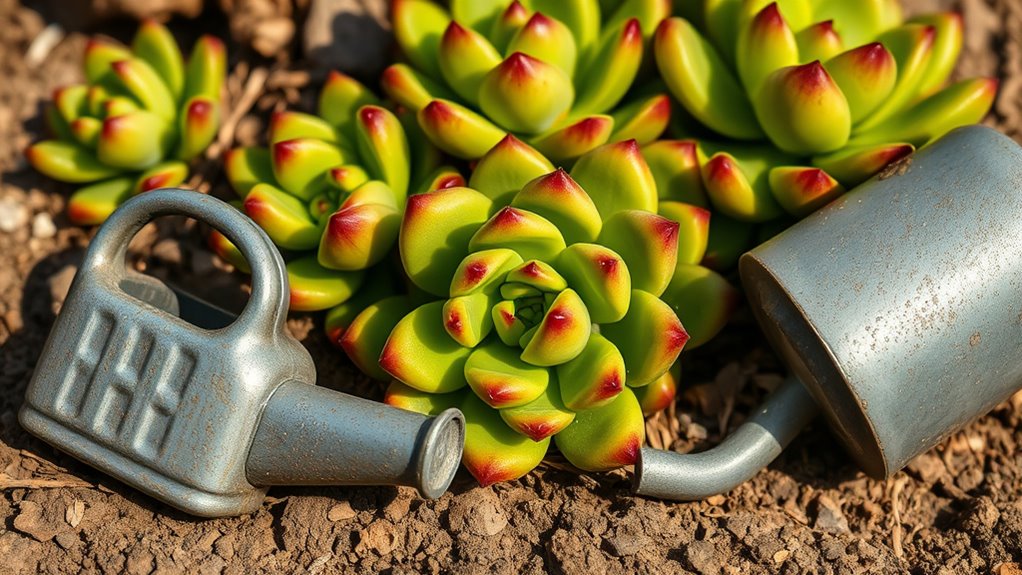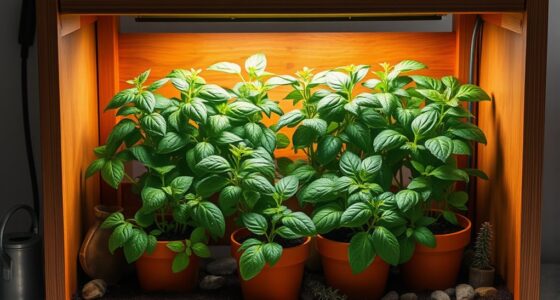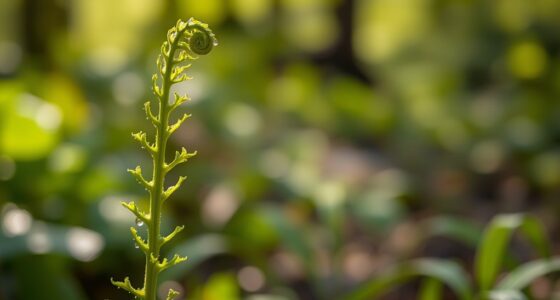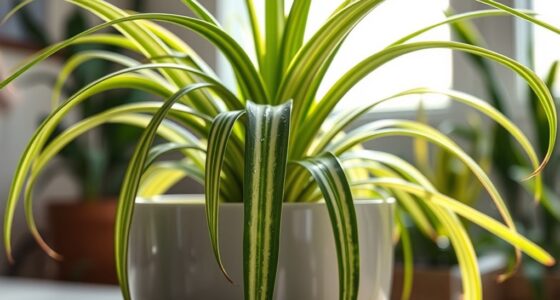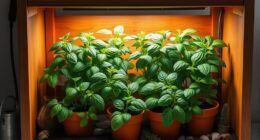Succulents die of thirst right in plain sight mainly because they’re often overwatered or their soil doesn’t drain properly, leading to root rot, which prevents water absorption. Ironically, many ignore their drought-tolerance and give frequent shallow waterings or use heavy, clay-rich soil that retains moisture. Sun and temperature swings also accelerate water loss or cause stress, making them appear healthy while suffering internally. To stop this, understanding their true needs and proper care is essential, and there’s more to uncover below.
Key Takeaways
- Succulents often appear healthy but may be dehydrated due to infrequent, shallow watering that doesn’t reach their roots.
- Overwatering or poor drainage causes root rot, preventing water absorption and leading to apparent dehydration.
- Signs like translucent or wilted leaves indicate dehydration, even if the plant looks lush on the surface.
- Environmental factors such as intense sunlight and high temperatures increase water loss, causing succulents to die of thirst.
- Lack of proper soil and drainage systems restrict water availability to roots, making succulents die from dehydration despite their drought tolerance.
Misunderstanding Succulents’ Water Needs
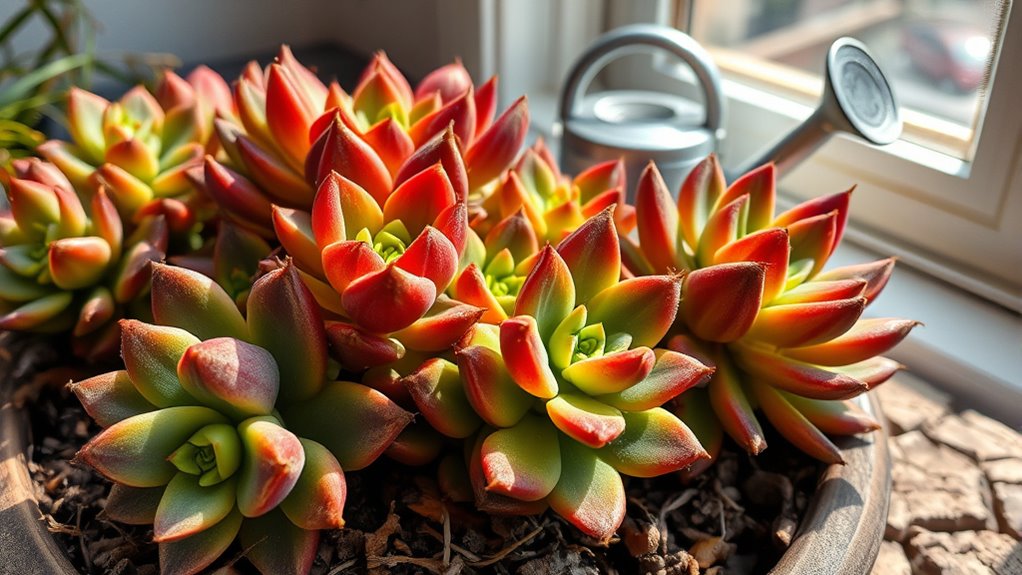
Many people mistakenly believe that succulents require frequent watering because they’re often mistaken for plants that need constant moisture. This watering misconception leads many to overwater, which can cause root rot and decay. You might think these plants need daily attention, but in reality, succulents thrive on infrequent, deep watering. The hydration myths surrounding succulents suggest they need constant hydration, but their thick leaves and stems are adapted to store water, not absorb it constantly. When you water too often, you disrupt their natural drought-tolerance and risk harming the plant. Understanding that succulents prefer to dry out between waterings is vital. Proper watering habits prevent common issues and ensure your succulents stay healthy and vibrant, defying the misconception that they require constant moisture. Recognizing plant adaptation is key to meeting their specific water needs and promoting long-term health.
The Role of Soil and Drainage in Plant Health
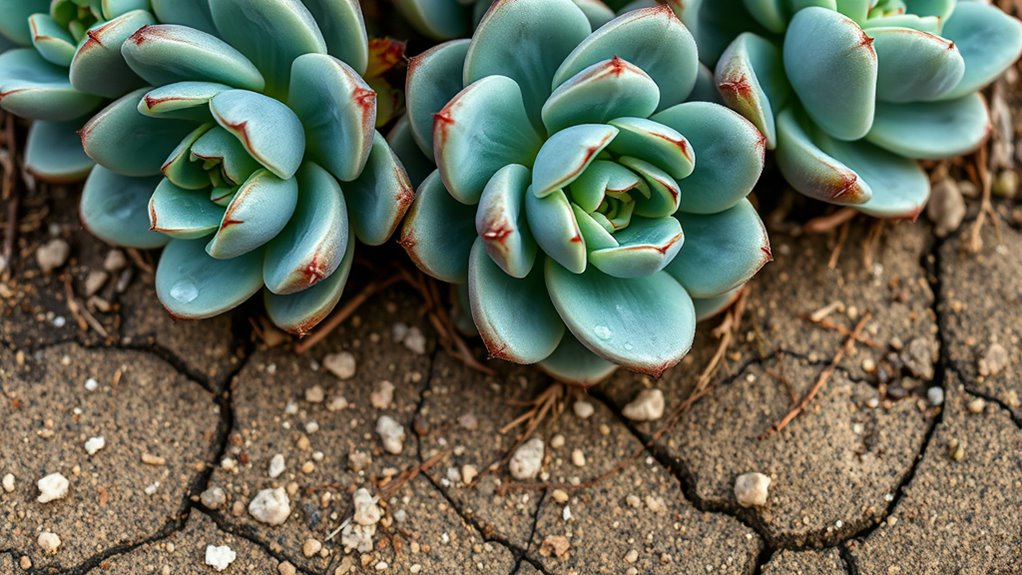
Choosing the right soil and ensuring proper drainage are vital for your succulents to thrive. The soil composition should be well-draining, with a mix that includes coarse sand, perlite, or pumice to prevent water from sitting around the roots. Avoid heavy, clay-rich soils that retain moisture and can lead to root rot. Effective drainage systems ensure excess water flows away quickly, reducing the risk of overwatering. When watering, make sure excess water can escape freely through the pot’s drainage holes. Proper soil and drainage allow roots to access oxygen and prevent waterlogging, which are essential for healthy growth. Without them, your succulents can quickly become waterlogged, leading to dehydration, rot, and eventual death. Additionally, maintaining appropriate watering habits ensures that moisture levels stay balanced, further protecting your plants from overwatering issues.
Common Overwatering Mistakes to Avoid
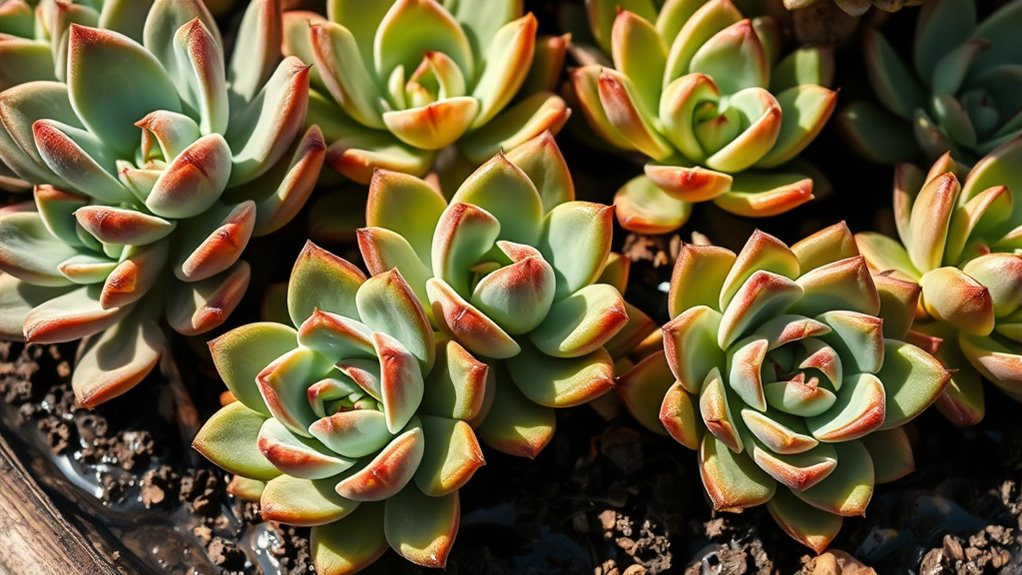
One of the most common mistakes when caring for succulents is overwatering, which can quickly lead to root rot and plant death. Many beginners forget that succulents’ history shows they evolved in dry environments, making them drought-tolerant. Overwatering hampers their natural adaptation by suffocating roots and promoting rot. When propagating succulents, watering too often can stunt growth and cause failure. To avoid this, always guarantee soil dries out completely between watering sessions. Remember, succulents are not just decorative; they’re resilient survivors with a rich history of thriving in arid conditions. Proper watering practices honor their natural adaptations and help prevent common mistakes that endanger your plants’ health. Water less frequently, and your succulents will thank you. Understanding plant resilience can help you better care for these hardy plants and avoid unnecessary mistakes.
The Impact of Pests and Diseases on Water Absorption

Pests and diseases can considerably disrupt a succulent’s ability to absorb water, often causing more harm than obvious surface damage. A pest infestation can damage roots or leaves, blocking water uptake. Disease symptoms like rot, mold, or spots weaken plant tissues, impairing their function. Here are three key impacts:
- Root damage from pests like mealybugs or scale reduces water absorption capacity.
- Fungal infections cause soft, rotting tissues that can’t transport water effectively.
- Leaf damage and discoloration hinder photosynthesis, further stressing water regulation.
- Additionally, proper watering techniques are essential to prevent over- or under-watering that can exacerbate these issues.
Addressing pest infestation early and recognizing disease symptoms are vital to maintaining healthy water absorption. Ignoring these issues leads to dehydration and eventual plant death, even if the soil appears dry.
How Temperature and Sunlight Affect Water Retention
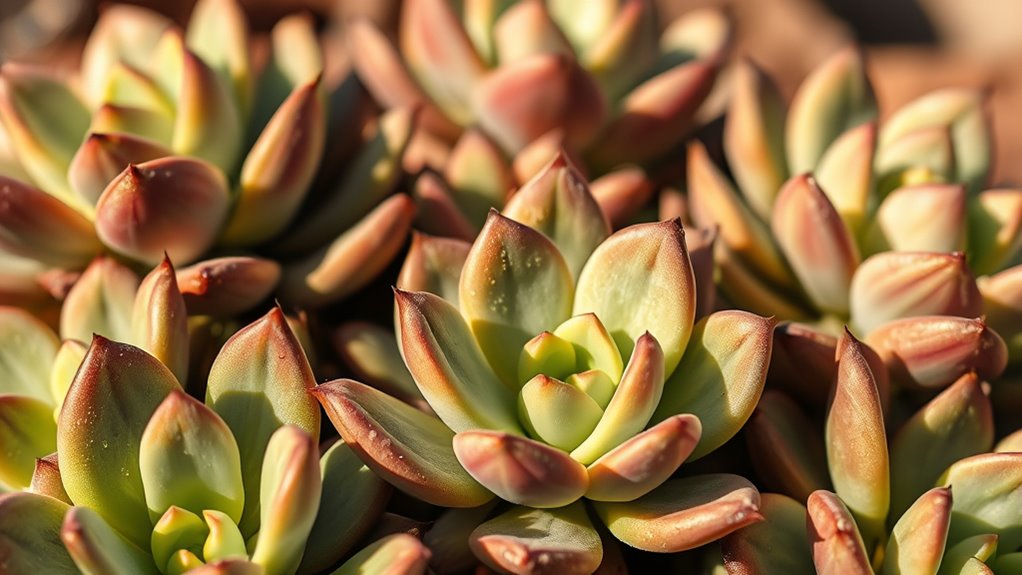
You’ll notice that intense sunlight can cause your succulents to lose water faster, especially in hot temperatures. When the temperature rises, plants tend to evaporate moisture more quickly, risking dehydration. Understanding how sunlight and temperature work together helps you keep your succulents healthy and well-hydrated. Proper insulation and shading techniques can help mitigate excessive water loss during peak sunlight hours.
Sunlight Intensity Impact
Sunlight intensity plays a crucial role in how succulents retain water, as intense sunlight and higher temperatures can cause them to lose moisture more rapidly. When sunlight is too strong, your plant’s photosynthesis efficiency increases, but this accelerates water evaporation from its tissues. To optimize water retention, consider these points:
- Moderate sunlight exposure: Too much sunlight boosts evaporation; avoid placing succulents in harsh, direct sunlight all day.
- Use shading or filters: Protect plants during peak hours to reduce stress and water loss.
- Choose appropriate locations: Find spots with indirect or filtered sunlight to maintain photosynthesis efficiency without excessive dehydration.
- Understanding the impact of sunlight intensity allows you to better manage watering schedules and prevent drought stress.
Understanding how sunlight intensity impacts water retention helps prevent succulents from drying out, ensuring they stay healthy and vibrant.
Temperature and Moisture
Have you ever noticed how temperature influences a succulent’s ability to hold onto water? When temperatures rise, your plant’s root structure can struggle to absorb moisture efficiently, especially if humidity levels are low. Hot, dry conditions cause water to evaporate quickly from the soil and leaves, increasing stress on the plant. Conversely, cooler temperatures help maintain moisture, allowing roots to absorb water more effectively. If the humidity levels are high, excess moisture around the roots can lead to rot, even if the temperature isn’t extreme. Understanding how temperature and moisture interact helps you manage watering more precisely. Keep in mind that a succulent’s root structure and the surrounding humidity levels directly impact its water retention, making temperature control essential for healthy growth. Additionally, evaporation rate is a key factor that influences how quickly water is lost from your succulent in different conditions.
Signs of Dehydration and When to Water
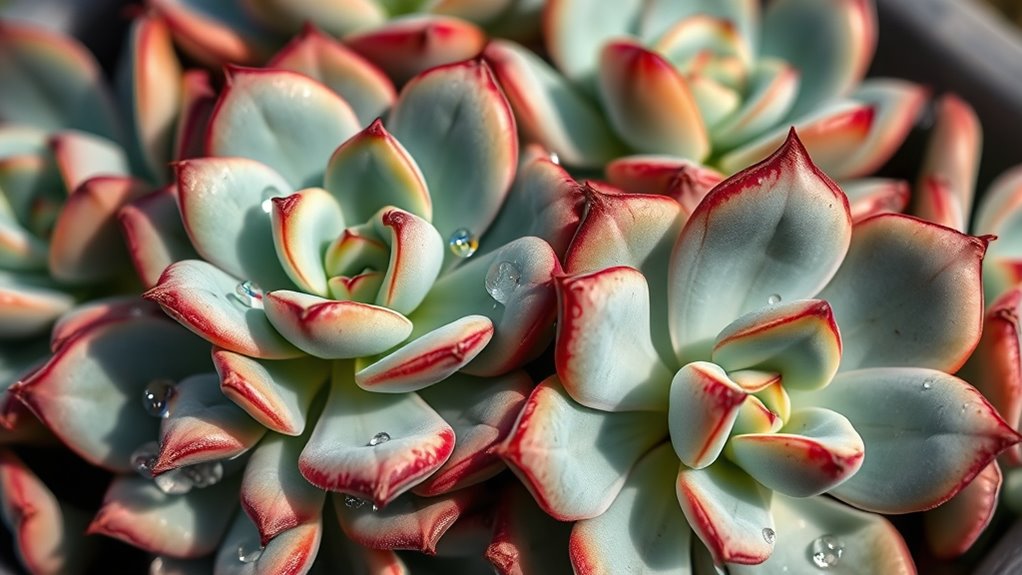
When your succulent shows signs of dehydration, you’ll notice wilting and soft, squishy leaves. Color changes, like pale or translucent foliage, also signal it needs water. Pay attention to these cues to determine the right moment to give your plant a drink. Additionally, understanding the types of headphone jacks can help ensure you’re using the proper connection when listening to your favorite music or podcasts.
Wilting and Softness
Wilting and softness are clear signs that your succulent is dehydrated and needs water. When your plant looks limp or its leaves feel mushy, it’s time to act. To prevent issues like root rot, you should carefully monitor your watering frequency. Here are key signs to watch for:
- Leaves that are limp, translucent, or easily fall off
- The plant appears droopy and lacks firmness
- Soil that stays soggy or feels overly moist for too long
Overwatering can cause root rot, so it’s essential to water only when the soil is completely dry. Adjust your watering schedule accordingly, and always guarantee proper drainage to keep your succulent healthy and vibrant.
Leaf Color Changes
Changes in leaf color are a clear indicator that your succulent may be dehydrated. When leaves turn pale, yellow, or translucent, it signals they’re lacking water or nutrients. Leaf discoloration can also point to nutrient deficiency, making it essential to observe subtle shifts. Here’s a quick guide:
| Leaf Color Change | Possible Cause |
|---|---|
| Pale or translucent leaves | Dehydration |
| Yellowing leaves | Nutrient deficiency or drought |
| Dark, shriveled leaves | Severe dehydration or root issues |
| Soft, mushy leaves | Overwatering or rot |
| Brown tips or edges | Underwatering or sunburn |
Recognizing these signs helps you decide when to water, preventing further stress or damage to your succulent. Additionally, understanding appliances can assist in creating optimal growing conditions, such as using grow lights or proper soil moisture levels.
Tips for Proper Care to Prevent Thirst-Related Death
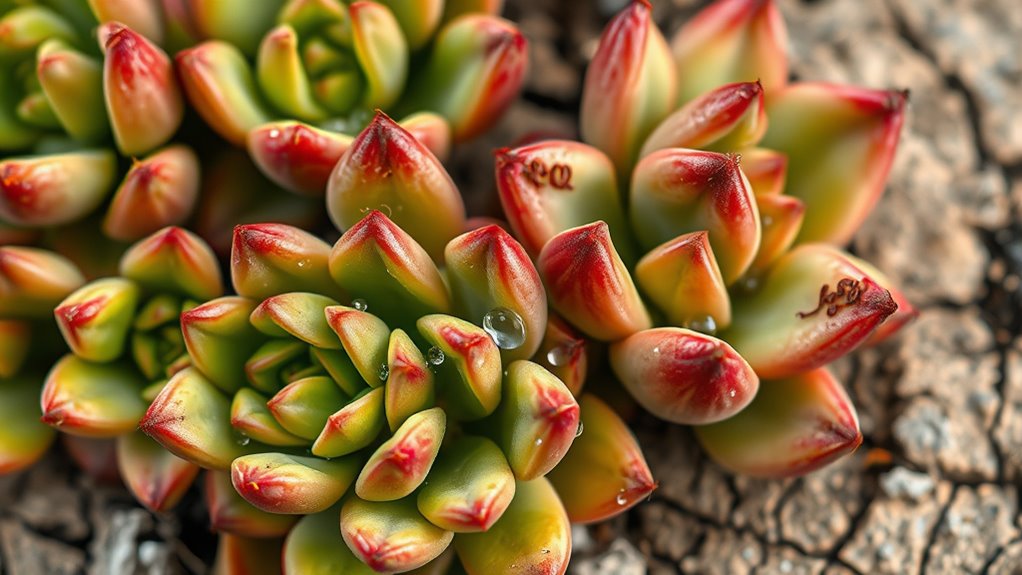
Proper watering is essential to keep your succulents healthy and prevent them from dying of thirst. To do this effectively, focus on three key tips.
- Adjust your watering frequency based on the season and environment—less often in winter, more during summer.
- Ensure your container has good drainage to prevent water from sitting at the bottom, which can lead to root rot.
- Always check the soil before watering; wait until it’s completely dry to avoid overwatering.
- Incorporating well-draining soil and understanding climate considerations can further help maintain optimal moisture levels for succulents.
Frequently Asked Questions
Can Succulents Survive Without Any Water at All?
You might wonder if succulents can survive without any water at all. While they’re drought adaptations and can go long periods without watering, they still need occasional moisture to stay healthy. The watering myths suggest neglect causes their death, but overwatering is often the real culprit. So, even tough succulents need some water; neglecting this can lead to their demise, especially if they’re left completely dry for too long.
How Does Humidity Influence Succulent Watering Requirements?
Humidity effects markedly influence your succulent’s watering needs by affecting moisture levels in the air. In high humidity, your plant absorbs more moisture, reducing how often you should water, since the soil stays damp longer. Conversely, in low humidity, moisture evaporates quickly, so you’ll need to water more frequently. Monitoring humidity levels helps you adjust watering schedules, ensuring your succulents stay healthy without over- or underwatering.
Are There Specific Succulent Varieties More Prone to Dehydration?
Ever wondered which succulent varieties are more prone to dehydration? You might notice that certain types, like Aloe Vera or Jade plants, show more signs of dehydration quickly. These varieties susceptibility to water loss makes them dehydration prone if not properly cared for. While all succulents are drought-tolerant, some are more vulnerable to drying out in plain sight, especially if you overlook their specific watering needs.
What Role Does Container Material Play in Water Retention?
Container material markedly affects water retention for your succulents. For example, porous materials like terracotta promote better soil drainage, preventing water from sitting too long and risking root rot. In contrast, plastic or glazed containers insulate better, retaining moisture longer and possibly causing overwatering if you’re not careful. Understanding how container insulation and soil drainage work together helps you choose the right pot, ensuring your succulents stay healthy and hydrated without drowning.
How Often Should I Inspect My Succulents for Signs of Thirst?
You should inspect your succulents regularly for visual cues like shriveled leaves or a dull, dry appearance. Check the soil’s moisture level, especially if you notice these signs, and adjust your watering frequency accordingly. Typically, watering once every 2-3 weeks suffices, but always base it on your plant’s specific needs and environment. Consistent inspections help prevent thirst and keep your succulents healthy.
Conclusion
If you think your succulents are thriving but suddenly show signs of weakness, don’t ignore it. Could it be dehydration hiding in plain sight? Sometimes, the answer isn’t just watering more—it’s understanding their true needs. Stay vigilant, watch for subtle changes, and question what you might be missing. Because in the world of succulents, a small mistake can turn a thriving plant into a thirsty, dying shadow—unless you catch it in time.
